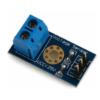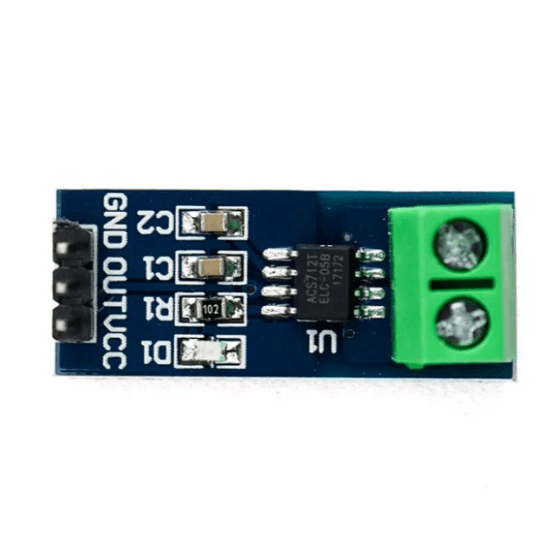Voltage Detection Sensor Module 25V
In stock
- You can also use the IICLCD1602 LCD to display voltage.
- By 3P connector, connect this module with the expansion of board Arduino
- Voltage input range: DC 0-25 V
- Voltage detection range: DC 0.02445 V to 25 V
- Voltage analog resolution : 0.00489 V
₹65.00 ₹99.00 (Price Excl. GST) ₹55.08
In stock
CompareA voltage detection Sensor is a simple but very useful module that uses a potential divider to reduce an input voltage by a factor of 5. The Voltage Sensor Module 25V allows you to use the analog input of a microcontroller to monitor voltages much higher than it is capable of sensing. For example with a 0-5V analog input range, you can measure a voltage up to 25V. This voltage sensor module also includes convenient screw terminals for easy and secure connection of a wire.
This module is based on the principle of resistive voltage divider design, which can make the red terminal connector input voltage 5 times smaller. Arduino analog input voltages up to 5 v, the voltage detection module input voltage not greater than 5Vx5=25V (if using 3.3V systems, input voltage not greater than 3.3Vx5=16.5V). Arduino AVR chips have 10-bit AD, so this module simulates a resolution of 0.00489V (5V/1023), so the minimum voltage of the input voltage detection module is 0.00489Vx5=0.02445V.
Keep in mind, you are restricted to voltages that are less than 25 volts. More than that and you will exceed the voltage limit of your Arduino input.
Connection Diagram
Features :
- Output Interface: “+ ” connected 5/3.3V, “-” connected GND, “s” connected Arduino AD pins
- DC input interface: red terminal positive with VCC, negative with GND
- You can also use the IICLCD1602 LCD to display voltage.
- By 3P connector, connect this module with the expansion of board Arduino, which not only makes it easier for you to detect voltage battery.
Package Includes :
1×Voltage Detection Sensor Module
Specifications
| Input Voltage (V) | 0 to 25 |
| Voltage Detection Range (V) | 0.02445 to 25 |
| Analog Voltage Resolution (V) | 0.00489 |
| Length (mm) | 28 |
| Width (mm) | 14 |
| Height (mm) | 13 |
| Weight (gm) | 4 |
| Shipment Weight | 0.005 kg |
Shipping & Returns
Due to the type of products we sell, we accept limited returns. Below are the conditions where we can accept a return request.
MANUFACTURING DEFECT
If you receive a product with a manufacturing defect, please notify us within 1 day of receiving the product, supported by the proper pictures and description. Once our support team accept the return, we will provide a replacement or a complete refund including the return shipping cost.
WRONG ITEM SHIPPED
If you receive a different product than the ordered one, please contact us within 1 day of receiving the product, supported by the proper pictures and description. Once our support team accept the return, we will provide a replacement or a complete refund including the return shipping cost.
LIMITATION OF RETURNS
We don’t accept returns for products damaged by improper use of the product. Moreover, we don’t accept the return if the ordered product is unsuitable for any specific application. Please read the product specifications and datasheet before selecting and ordering a product.
WHAT VOID WARRANTY?
If the product is subject to misuse, tampering, static discharge, accident, water or fire damage, use of chemicals & soldered or altered in any way.
SHIPPING
We ship all over India. Please contact our support team at info@inventkart.com for any questions related to shipping.
Based on 0 reviews
Be the first to review “Voltage Detection Sensor Module 25V”
You must be logged in to post a review.
You may also like…
-
All Products, Current/Voltage
5A range Current Sensor Module ACS712
- Low-noise analog signal path.
- Device bandwidth is set via the new FILTER pin.
- 5 µs output rise time in response to step input current.
- Small footprint, low-profile SOIC8 package.
- 2.1 kV RMS minimum isolation voltage from pins 1-4 to pins 5-8.
SKU: IK-189 -
All Products, Arduino Boards
Arduino Uno R3 SMD Compatible Development Board(Without cable)
- Microcontroller ATmega328 (SMD) – Interface CH340G
- Operating Voltage: 5V
- Input Voltage (recommended): 7-12V
- Input Voltage (limits): 5-20V
- Digital I / O Pins 14 (of which 6 provide PWM output)
- Analog Input Pins: 6
SKU: IK-112















There are no reviews yet.